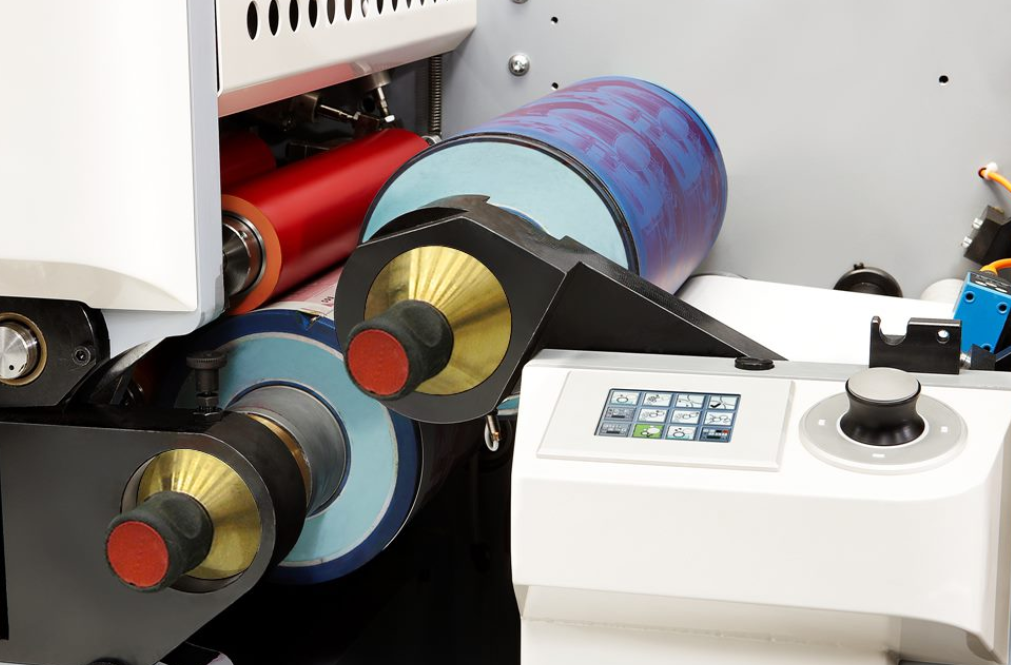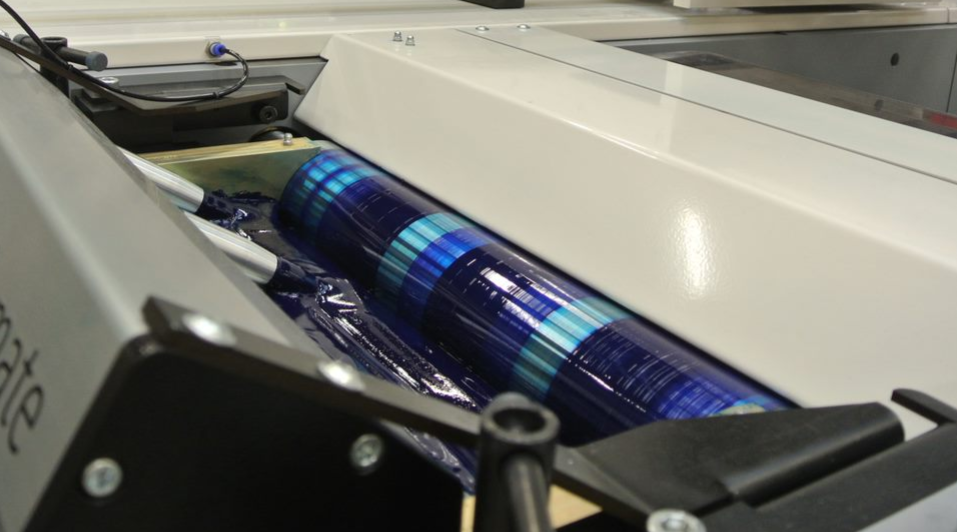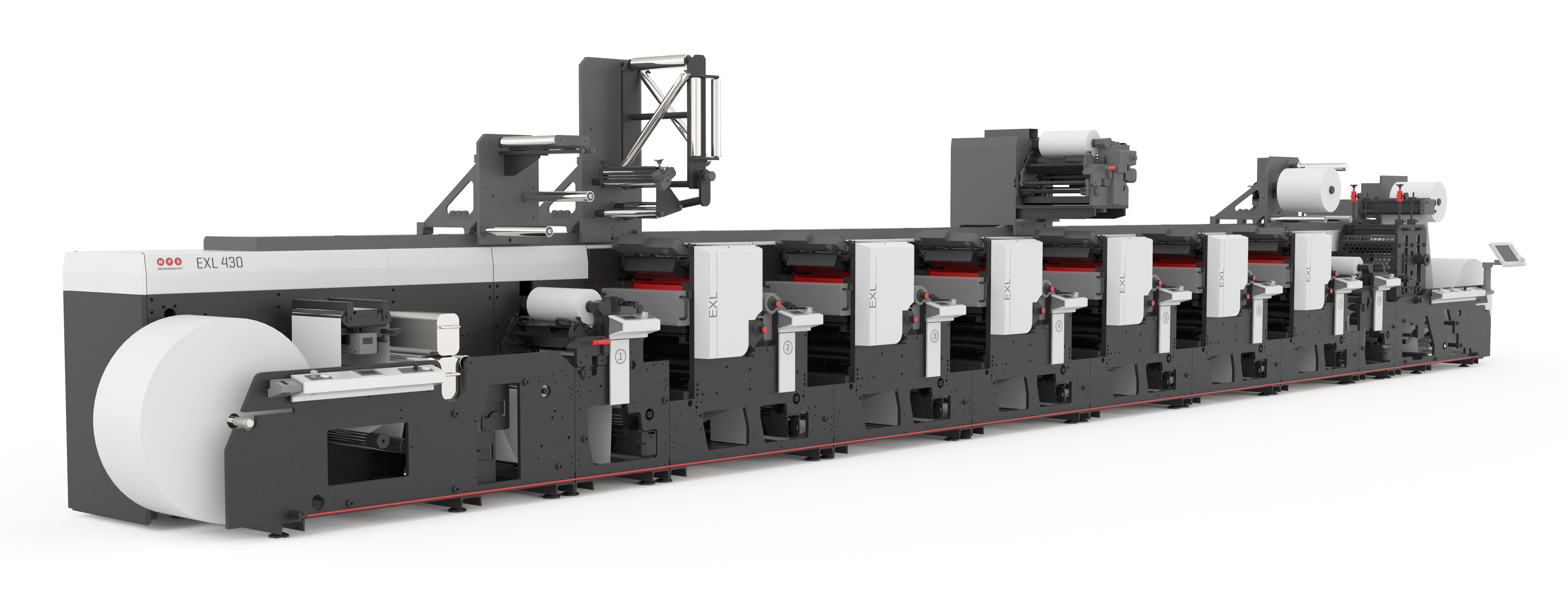The offset lithographic printing process, commonly known as offset, has been around since 1796 and invented by a German author and actor, Alois Senefelder, as a cheap method of producing theatrical artwork. It was originally done on a flat stone or metal surface.
Today, there are different types of offset presses including:
- Narrow web
- Wide web
- Sheetfed
Offset printing process explained
The basic principle of offset printing is that ink and water don’t mix.
The image area, which has the ink applied, is oleophilic. It repels water but accepts the oil-based ink. The non-image area is hydrophilic. It repels oil/ink but accepts the water, thus only leaving the image on the plate.
 Narrow web offset print unit
Narrow web offset print unit
The ink is metered by the ink duct. These have keys that can be adjusted to regulate the ink that is applied to the plate by the inking rollers, then to the form rollers which contact the printing plate.
 Ink duct with automatic adjustment for the keys
Ink duct with automatic adjustment for the keys
Once the ink is applied, it passes through the water roller, which cleans off the ink from the non-image area, leaving the image ready to be transferred to a rubber blanket.
When the image is on the rubber blanket, it is transferred to the substrate that runs between the blanket and an impression cylinder. This same process continues on all required units. Once in register, the image or text is ready to be printed.
Common issues with offset printing
Offset printing has a wide variety of options for most requirements, but also has its challenges.
It can be difficult for some operators to achieve a good balance between water and ink, while also dealing with adjustment of the ink keys.
Other issues are:
1. EmulsificationOften a printer may see ink printing on the edges of the substrate and may think it’s because of lack of water. They may turn the dwell and apply more water. But unless they check the sheen on the plate, this may cause emulsification making the ink contaminated.
To fix this, it would be best to wash up and check if the ink is not contaminated in the ink duct. Or in a mild case, turning off the water and sheeting the ink onto the substrate can help resolve the issue.
2. Catch-upThis happens when ink appears on the non-image area because there is not enough water on the plate. To resolve this issue, you can turn up the water by a few percent at a time and look for a matt to light sheen on the plate.
3. Plate storageThe issue that can arise with plate storage is the overuse of gum arabic, which is what protects the plate in between runs.
If the plate is cleaned and the gum is then heavily applied and not properly buffed, the next time the plate is used it can cause gum blindness. This will prevent the affected parts of the plate to work effectively and will need to be remade.
4. pH levelsWater that supplies the fountain roller needs to be a certain isopropyl alcohol and pH level to achieve proper wetting and effective wiping of the printing plate.
The plate manufacturing company can determine the optimum pH level. Regular checks, cleaning of the filter, and system flushing is recommended.
As with all printing processes, there are many more issues and variables with offset printing. This does not take away from the fact that offset still has its advantages.
Advantages of offset printing
Offset printing is one of the most common and oldest processes, but it still plays a big role in the print industry.
Offset advantages include:
1. High qualityOut of all the printing processes, offset printing produces the highest quality of print and is repeatable from low to high speeds.
Therefore, it’s a popular choice for wine and spirit labels, healthcare, books, newspapers, magazines artwork, and photographs. Offset is also one of the processes used for printing currency and security printing.
2. Low-cost platesThe plates used in offset printing are inexpensive, and reusable. Therefore, a good option for short and long run printing jobs.
Another advantage are jobs that require frequent plate changes, which is why offset it’s used for printing newspapers and magazines.
3. Fast turnaroundFast turnaround times can be achieved with offset presses running extremely fast with high-quality printing.
4. Print flexibilityWith offset, you can print on different substrates from self-adhesive, paper, polys, nylon, fabrics, wood, and more. The image is transferred to a blanket and then the substrate.
You also have a choice of using a combination of print methods for more flexibility.
The combination press consists of an offset unit and other units such as gravure, flexo, digital and screen units. These can be added to a fixed unit or on a rail system to move to where it’s required.
Applications for hot and cold foil, embossing, de-lam and re-lam with turner bars, multi-label units, lamination, in-register lamination, and die cutting are also possible. Because you can combine these processes, you now have the ultimate flexibility for your company to win new customers.
A combination press combined with offset printing is a valuable press for any narrow web printing company.
 MPS EXL-O narrow web offset press
MPS EXL-O narrow web offset press
In summary
With all the above and after analysing the pros and cons, offset printing is a process companies should consider when purchasing their next printing press. Whether one should choose an offset-only press or a combination press depends on job requirements. The fact of the matter: offset presses are here to stay.
I think when combined with other printing methods and embellishments, it gives you a very diverse and capable press which will serve and meet the demands of printing companies and customers.
Get in touch
If you have questions or suggestions on this or any of my other snippets, please feel free to contact me.
You can reach me via LinkedIn or via email k.marsh@mps4u.com.